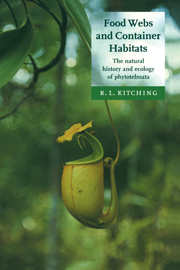14 - A food-web templet
A summarising statement
Published online by Cambridge University Press: 26 August 2009
Summary
All ecological phenomena can be viewed in light of key axes along which selection has occurred and against which various emergent properties of ecological systems can be matched. In their simplest (and perhaps most useful) form these axes are the universal ones of space and time. They can be transformed to represent changes in the magnitude of key processes such as competition, disturbance and stress. These axes have been used to construct so-called templets (to retain Southwood's, 1977, deliberately archaic spelling) as synthesising devices which have been very effective in providing an heuristic framework for understanding complex, multivariate phenomena.
Other templets
The templets of Southwood (1977) and Grime (1979) introduced the ideas of semi-diagrammatic summaries of ecological ideas. In both these cases the authors were making statements about the life-history strategies and processes of selection in animals and plants respectively. Southwood's model defines habitat heterogeneity in terms of time (‘durational stability’) and space. Against the temporal scale he places the pre-existing notion of r and K selection – basically the ends of a continuum of species-specific strategies ranging from the rapid-breeding, highly dispersive, short-lived, poorly competitive through to the slow-breeding, sedentary, long-lived and highly specialised. Against the spatial axis he erects another selective continuum which he calls ‘adversity selection’ – a concept devised by Whittaker (1975) to describe the syndrome of selective pressures and adaptational responses observed in plants growing under varying degrees of stress.
- Type
- Chapter
- Information
- Food Webs and Container HabitatsThe Natural History and Ecology of Phytotelmata, pp. 293 - 300Publisher: Cambridge University PressPrint publication year: 2000



